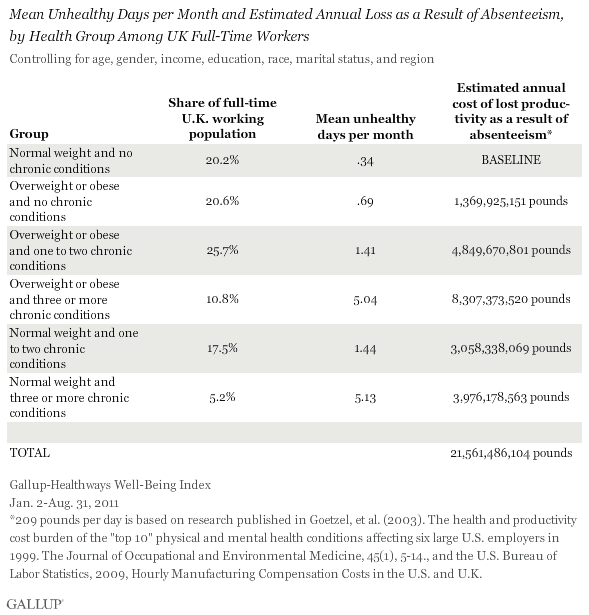WASHINGTON, D.C. -- Full-time workers in the U.K. who are overweight or obese and have other chronic health conditions miss an estimated 103 million additional days of work each year compared with healthy workers -- resulting in an estimated cost of more than 21 billion pounds in lost productivity annually.

These findings are based on data from the first eight months of Gallup-Healthways Well-Being Index tracking in the U.K., collected between Jan. 2 and Aug. 31, 2011. Gallup surveyed 8,866 residents in the U.K., 3,908 of which are full-time employees, meaning they say they work at least 30 hours per week.
Chronic health conditions in this analysis include being overweight or obese; having ever been diagnosed with a heart attack, high blood pressure, high cholesterol, cancer, diabetes, asthma, or depression; and recurring physical pain in the neck or back or knee or leg in the last 12 months. Gallup calculated unhealthy days using respondents' answers to the question, "During the past 30 days, for about how many days did poor health keep you from doing your usual activities?"
Full-time workers who are a normal weight and do not suffer from chronic health conditions make up 20.2% of the U.K. workforce and average .34 unhealthy days each month (or about 4 days per year). The average number of unhealthy days per month doubles to .69 among those who are overweight or obese and do not have additional chronic health conditions. Unhealthy days per month increase further to 1.41 for workers who are overweight or obese and have one to two additional chronic health conditions. Workers who are an above-normal weight and have three or more chronic health conditions report a significantly higher average of 5.04 unhealthy days per month. A similar pattern exists among workers who are a normal weight but have either currently or at some point in their lives other chronic health conditions.
To estimate how unhealthy days per month translate into missed work days, Gallup asked workers this question: "Earlier, you indicated that you had xx days in the last month where poor health prevented you from doing your usual activities. How many actual work days in the last month did you not work due to poor health?" The results indicated that one unhealthy day per month for full-time workers is equivalent to about 0.31 actual missed days of work.
See page 2 for a full description for estimating the economic cost of unhealthy days.
Clerical and Service Workers Suffer More Unhealthy Days
Clerical and service workers in the U.K. report an average of two unhealthy days per month -- more than any other major occupational group surveyed. At the other end of the spectrum are construction workers, managers/executives, and business owners, all of whom report fewer than one unhealthy day each month. These results hold after controlling for all major demographic differences, including age and gender.

Implications
The links between obesity and other chronic health conditions are well-known, including diabetes, depression, high cholesterol, high blood pressure, and heart attack. The results of this new analysis expand on these known links to reveal the combined effects of being overweight or obese and having additional chronic conditions on absenteeism at work.
Considering that many British adults suffer from several chronic health issues, U.K. employers face a challenge in reducing lost productivity as a result of workers' mostly preventable health issues.
Additionally, the cost of 21 billion pounds in lost productivity estimated in this analysis would almost certainly increase if it included presenteeism. An analysis of presenteeism would account for when employees go to work but are less productive in their jobs because of poor health or well-being. Including part-time employees would add to the estimate of costs in lost productivity.
Ultimately, U.K. employers and employees will need to improve the health situation of the nation's entire workforce to reduce these costs in lost productivity over time.
About the Gallup-Healthways Well-Being Index
The Gallup-Healthways Well-Being Index tracks well-being in the U.S., U.K., and Germany and provides best-in-class solutions for a healthier world. To learn more, please visit well-beingindex.com.
Survey Methods
Results are based on telephone interviews conducted as part of the Gallup-Healthways Well-Being Index survey Jan. 2-Aug. 31, 2011, with a random sample of 8,866 adults, aged 18 and older, living in in the United Kingdom, selected using random-digit-dial sampling. Of these, 3,908 were employed full time at the time of the interview.
For results based on the total sample of national adults, one can say with 95% confidence that the maximum margin of sampling error is ±2 percentage points.

Interviews are conducted with respondents on landline telephones and cellular phones. Each daily sample includes a minimum quota of 5 cell phone respondents and 29 landline respondents, with additional minimum quotas among landline respondents for gender within the regions. Landline respondents are chosen at random within each household on the basis of which member had the most recent birthday.
Samples are weighted by gender, age, education, region, adults in the household, and cell phone status. Demographic weighting targets are based on the most recently published population data from the Census Bureau for Northern Ireland, Scotland, England, and Wales. All reported margins of sampling error include the computed design effects for weighting and sample design.
In addition to sampling error, question wording and practical difficulties in conducting surveys can introduce error or bias into the findings of public opinion polls.
For more details on Gallup's polling methodology, visit https://www.gallup.com/.
Step 1: Converted full-time workers' average number of unhealthy days per month into an annual average.
Step 2: Converted the average number of annual unhealthy days into the average number of actual missed work days each year by multiplying each value by 0.31. The 0.31 conversion factor, as noted in the article, is based on an analysis of workers' responses to this question: "Earlier, you indicated that you had xx days in the last month where poor health prevented you from doing your usual activities. How many actual work days in the last month did you not work due to poor health?"
Step 3: Multiplied the average annual number of missed work days for each group by the actual number of full-time workers in each group. Gallup calculated the number of full-time workers in each group based on 49.1 million U.K. adults, which was then multiplied by the percentage of adults who have a full-time job (about 45% according to Gallup).
Step 4: Calculated the number of incremental missed work days per year for each group by multiplying the total number of workers in each group by the average number of unhealthy days per year beyond the unhealthy days per year for the baseline group of workers who are normal weight and have zero chronic health conditions.
